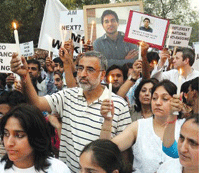Perhaps the biggest opportunity missed by the Congress-led United Progressive Alliance coalition government, which has reigned, even if not ruled, in New Delhi for the past five years, was to implement systemic reforms in education. Under septuagenarian Union HRD minister Arjun Singh, who was preoccupied with politicising higher education rather than reforming it in the interest of the world’s largest youth population, Indian education marked time, sliding imperceptibly downwards.
 Take for instance the inability of the HRD ministry to stamp out the ragging menace in the country’s 431 universities and 21,000 colleges. The ‘lynching’ to death on March 8 of Aman Kachru (19), a medical undergraduate student of the Dr. Rajendra Prasad Government Medical College in the Kangra district of Himachal Pradesh, glaringly indicated the stark reality that ragging is alive on the country’s campuses despite repeated admonitions of the Supreme Court.
Take for instance the inability of the HRD ministry to stamp out the ragging menace in the country’s 431 universities and 21,000 colleges. The ‘lynching’ to death on March 8 of Aman Kachru (19), a medical undergraduate student of the Dr. Rajendra Prasad Government Medical College in the Kangra district of Himachal Pradesh, glaringly indicated the stark reality that ragging is alive on the country’s campuses despite repeated admonitions of the Supreme Court.
“In the absence of stern deterrents, the ragging tradition will persist and college authorities will continue to label ragging deaths as suicides due to academic pressure. Moreover right now thousands of ragging incidents are unreported, because teachers and senior students continue to believe that ragging is a healthy interactive personality development exercise. The media only reports sensational cases and parents and relatives fail to understand the pain of victims,” says Harsh Agarwal, a former ragging victim who runs the Delhi-based CURE (Coalition to Uproot Ragging from Education).
Predictably the tragic ragging death of young Aman Kachru in Himachal, which drew poignant electronic media coverage, has evoked a traditional knee-jerk response from the Delhi-based University Grants Commission (UGC), which supervises higher education in India. “The commission has given an ultimatum to educational institutions to either take preventive steps to combat ragging or face funding cuts,” said Harminder Kaur Chauhan, joint director of UGC, to media persons in Chandigarh, adding that a high-powered committee has been formed to curb ragging from the next academic session, and colleges and universities have been told to detail punishments for ragging in their prospectuses.
Likewise in Delhi UGC chairman Dr. S.K. Thorat spoke of convening a conclave of all 17 regulators and monitoring councils — from AICTE to MCI — to formulate tough new anti-ragging regulations. A conclave draft reportedly contains provisions for cancellation and rustication of students indulging in ragging for two to four semesters, and withdrawal of UGC recognition to institutions.
But educationists in the national capital feel that unless all the 50 recommendations of the R.K. Raghavan Committee, appointed by the Supreme Court to suggest ways and means to stampout the ragging menace from institutions, are implemented, this scourge can’t be contained. The Raghavan Committee was appointed in December 2006 by the HRD ministry following a Supreme Court directive, and submitted its report with 50 recommendations to the apex court in May 2007, which accepted them on February 11, 2008. “I am confident that if all the Raghavan Committee recommendations are followed and implemented, the ragging menace can be curbed,” says Dr. Rajendra Prasad, principal of Ramjas College, who served as a member on the Raghavan Committee. “One of the major recomme-ndations overlooked by the Union HRD and home ministries, is to make ragging a punishable crime under the Indian Penal Code, 1860,” he adds.
Meanwhile, shell-shocked by his son’s ragging murder, Prof. Rajender Kachru, currently teaching in the Dar-es-Salaam University in Tanzania, has started an Aman Movement to root out this sadistic ritual from India’s campuses. The prime objective of the Aman Movement is to ensure that educational institutions adopt a “zero tolerance” policy towards ragging and initiate strict action against students found guilty of it.
“Eight years on and two Supreme Court-appointed committees later, the celebrated public interest litigation method of reforming India did not come to the rescue of Aman Satya Kachru. What the Supreme Court process did do, instead, was to make the state governments and HRD ministry lazy. They gave up passing and implementing anti-ragging laws. The few states that did so, as the Raghavan committee shockingly found, have not notified them,” writes activist Shivam Vij on his website, www.stop ragging.org.
And so until the next casualty.
Autar Nehru (Delhi)